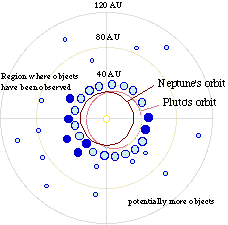Click on image for full size
Image courtesy of Solar System Live, which was implemented by John Walker and is Copyright © 1989 by Jef Poskanzer
How far is the Earth from the Sun, the Moon and all the other planets? How far are all of the planets from the Sun? Do you know of a software that tracks the planets in real-time?
There is a really neat internet program called Solar System Live that shows where all of the planets and the Sun are. If you go to that page, you'll see an image similar to the one on the left. Below the image, you'll see the distance from the Sun, the Moon and all of the planets to Earth. It's given in the measure of an A.U. (Astronomical Unit).To get this distance in kilometers and miles, have an adult help you with this math...here's an example! It says that today Saturn is 8.833 A.U. away from Earth. To get that distance in kilometers, multiply the A.U. distance by 149,600,000. To get that distance in miles, multiply the A.U. distance by 93,000,000. So Saturn is 1,321,416,800 kilometers from Earth (8.833x149,600,000) and 821,190,000 miles from Earth today (8.833x93,000,000). The same thing can be done for all of the planets.
The distance of the planets from the Sun is given on these pages: Mercury, Venus, Earth, Mars, Jupiter, Saturn, Uranus, Neptune, Pluto.
Submitted by Robert (Maine, USA), Erin (Michigan, USA), Randy, Kate (England), Miss Holts' elementary classroom, Lorna (England), Tara (Georgia, USA), Colleen (Colorado, USA), Edith (Virginia, USA)
(January 30, 2001)












